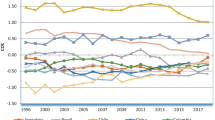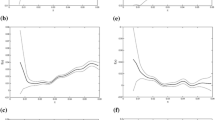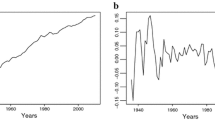Abstract
We investigate the causality between corruption and income inequality within a multivariate framework using a panel data set of all 50 U.S. states over the period 1980 to 2004. The heterogeneous panel cointegration test by Pedroni (Oxf. Bull. Econ. Stat. 61:653–670, 1999; Econom. Theory 20:597–627, 2004) indicates that in the long run corruption and the unemployment rate have a positive and statistically significant impact on income inequality while a negative impact is found for real personal income per capita, education, and unionization rate. The Granger-causality results associated with a panel vector error correction model indicate both short-run and long-run bidirectional causality between corruption and income inequality.
Similar content being viewed by others
References
Breitung, J. (2000). The local power of some unit root tests for panel data. Advances in Econometrics, 15, 161–177.
Carrioni-Silvestre, J. L., del Barrio-Castro, T., & Lopez-Bazo, E. (2005). Breaking the panels: An application to GDP per capita. Econometrics Journal, 8, 159–175.
Choi, I. (2001). Unit root tests for panel data. Journal of International Money and Finance, 20, 249–272.
Chong, A., & Calderon, C. (2000). Institutional quality and income distribution. Economic Development and Cultural Change, 48, 761–786.
Chong, A., & Gradstein, M. (2007). Inequality and institutions. Review of Economics and Statistics, 89, 454–465.
Dincer, O. C. (2008). Ethnic and religious diversity and corruption. Economics Letters, 99, 98–102.
Dincer, O. C., & Gunalp, B. (2008). Corruption, income inequality and poverty in the United States. FEEM Working Paper 54.
Engle, R. F., & Granger, C. W. J. (1987). Cointegration and error correction: Representation, estimation, and testing. Econometrica, 55, 251–276.
Fisman, R., & Gatti, R. (2002). Decentralization and corruption: Evidence from U.S. federal transfer programs. Public Choice, 113, 25–35.
Fredriksson, P. G., List, J. A., & Millimet, D. L. (2003). Bureaucratic corruption, environmental policy and inbound US FDI: Theory and evidence. Journal of Public Economics, 87, 1407–1430.
Glaeser, E. L. (2005). Inequality. HIER Discussion Paper 2078.
Glaeser, E. L., & Saks, R. E. (2006). Corruption in America. Journal of Public Economics, 90, 1053–1072.
Goel, R., & Rich, D. (1989). On the economic incentives for taking bribes. Public Choice, 61, 269–275.
Gupta, S., Davoodi, H., & Alonso-Terme, R. (2002). Does corruption affect income inequality and poverty? Economics of Governance, 3, 23–45.
Hadri, K. (2000). Testing for stationarity in heterogeneous panel data. Econometric Journal, 3, 148–161.
Im, K. S., Pesaran, M. H., & Shin, Y. (2003). Testing for unit roots in heterogeneous panels. Journal of Econometrics, 115, 53–74.
Johnston, M. (1989). Corruption, inequality, and change. In P. M. Ward (Ed.), Corruption, development and inequality (pp. 13–37). London: Routledge.
Kao, C., & Chiang, M. H. (1999). On the estimation and inference of a cointegrated regression in panel data. Working paper, Syracuse University.
Kweit, R. W., & Kweit, M. G. (1998). People and politics in urban America. London: Routledge.
Levin, A., Lin, C. F., & Chu, C. (2002). Unit root tests in panel data: Asymptotic and finite-sample properties. Journal of Econometrics, 108, 1–24.
Li, H., Xu, L. C., & Zou, H. F. (2000). Corruption, income distribution, and growth. Economics and Politics, 12, 155–182.
Lütkepohl, H. (1982). Non-causality due to omitted variables. Journal of Econometrics, 19, 267–378.
Meier, K. J., & Holbrook, T. M. (1992). I seen my opportunities and I took’em: Political corruption in the American states. Journal of Politics, 54, 135–155.
Maddala, G. S., & Wu, S. (1999). A comparative study of unit root tests with panel data and a new simple test. Oxford Bulletin of Economics and Statistics, 61, 631–652.
Maxwell, A. E., & Winters, R. F. (2004). A quarter century of data on corruption in the American states. Mimeo.
Pedroni, P. (1999). Critical values for cointegration tests in heterogeneous panels with multiple regressors. Oxford Bulletin of Economics and Statistics, 61, 653–670.
Pedroni, P. (2000). Fully modified OLS for heterogeneous cointegrated panels. Advanced in Econometrics, 15, 93–130.
Pedroni, P. (2004). Panel cointegration: Asymptotic and finite sample properties of pooled time series tests with an application to the PPP hypothesis: New results. Econometric Theory, 20, 597–627.
Pesaran, H. M., Shin, Y., & Smith, R. P. (1999). Pooled mean group estimation of dynamic heterogeneous panels. Journal of the American Statistical Association, 94, 621–634.
Phillips, P., & Moon, H. (1999). Linear regression limit theory for nonstationary panel data. Econometrica, 67, 1057–1111.
Ravallion, M. (1997). Can high-inequality developing countries escape absolute poverty? World Bank Policy Research Working Paper 1775.
Shughart, W. F. II, Tollison, R.D., & Yan, Z. (2003). Rent seeking into the income distribution. Kyklos, 56, 441–456.
Tanzi, V. (1998). Corruption around the world: Causes, consequences, scope, and cures. IMF Staff Papers, 45, 559–594.
Uslaner, E. (2006). Corruption and inequality. UNU-WIDER Research Paper 34.
You, J., & Khagram, S. (2005). A comparative study of inequality and corruption. American Sociological Review, 70, 136–157.
Author information
Authors and Affiliations
Corresponding author
Rights and permissions
About this article
Cite this article
Apergis, N., Dincer, O.C. & Payne, J.E. The relationship between corruption and income inequality in U.S. states: evidence from a panel cointegration and error correction model. Public Choice 145, 125–135 (2010). https://doi.org/10.1007/s11127-009-9557-1
Received:
Accepted:
Published:
Issue Date:
DOI: https://doi.org/10.1007/s11127-009-9557-1




